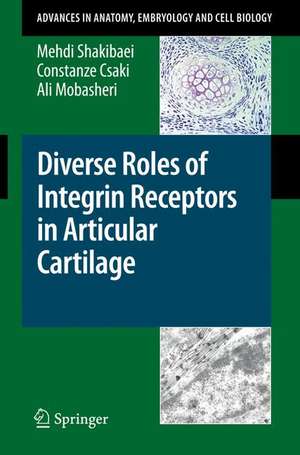Diverse Roles of Integrin Receptors in Articular Cartilage: Advances in Anatomy, Embryology and Cell Biology, cartea 197
Autor Mehdi Shakibaei, Constanze Csaki, Ali Mobasherien Limba Engleză Paperback – 12 iun 2008
Din seria Advances in Anatomy, Embryology and Cell Biology
- 5%
 Preț: 1146.33 lei
Preț: 1146.33 lei - 5%
 Preț: 721.19 lei
Preț: 721.19 lei - 15%
 Preț: 637.13 lei
Preț: 637.13 lei -
 Preț: 381.81 lei
Preț: 381.81 lei - 15%
 Preț: 644.95 lei
Preț: 644.95 lei - 5%
 Preț: 1025.16 lei
Preț: 1025.16 lei - 15%
 Preț: 689.97 lei
Preț: 689.97 lei - 15%
 Preț: 577.07 lei
Preț: 577.07 lei - 15%
 Preț: 580.36 lei
Preț: 580.36 lei - 5%
 Preț: 393.51 lei
Preț: 393.51 lei -
 Preț: 408.66 lei
Preț: 408.66 lei -
![Die Schlüpfdrüse der Geburtshelferkröte (Alytes o. obstetricans [LAURENTI]) und anderer Froschlurche](https://i4.books-express.ro/bs/9783662239742/die-schluepfdruese-der-geburtshelferkroete-alytes-o-obstetricans-laurenti-und-anderer-froschlurche.jpg) Preț: 408.27 lei
Preț: 408.27 lei - 5%
 Preț: 1090.61 lei
Preț: 1090.61 lei - 5%
 Preț: 705.11 lei
Preț: 705.11 lei - 5%
 Preț: 706.04 lei
Preț: 706.04 lei - 5%
 Preț: 357.61 lei
Preț: 357.61 lei - 5%
 Preț: 704.59 lei
Preț: 704.59 lei - 5%
 Preț: 705.11 lei
Preț: 705.11 lei - 5%
 Preț: 359.42 lei
Preț: 359.42 lei - 5%
 Preț: 711.52 lei
Preț: 711.52 lei - 15%
 Preț: 635.47 lei
Preț: 635.47 lei - 15%
 Preț: 631.72 lei
Preț: 631.72 lei - 15%
 Preț: 633.35 lei
Preț: 633.35 lei - 15%
 Preț: 632.37 lei
Preț: 632.37 lei - 5%
 Preț: 706.60 lei
Preț: 706.60 lei - 15%
 Preț: 631.07 lei
Preț: 631.07 lei - 5%
 Preț: 707.13 lei
Preț: 707.13 lei - 5%
 Preț: 707.33 lei
Preț: 707.33 lei - 5%
 Preț: 359.60 lei
Preț: 359.60 lei - 5%
 Preț: 707.69 lei
Preț: 707.69 lei - 5%
 Preț: 707.13 lei
Preț: 707.13 lei - 5%
 Preț: 708.06 lei
Preț: 708.06 lei - 5%
 Preț: 706.41 lei
Preț: 706.41 lei - 5%
 Preț: 708.78 lei
Preț: 708.78 lei - 5%
 Preț: 705.68 lei
Preț: 705.68 lei - 5%
 Preț: 705.11 lei
Preț: 705.11 lei - 5%
 Preț: 706.77 lei
Preț: 706.77 lei - 15%
 Preț: 635.15 lei
Preț: 635.15 lei - 15%
 Preț: 631.07 lei
Preț: 631.07 lei - 5%
 Preț: 706.77 lei
Preț: 706.77 lei - 5%
 Preț: 706.04 lei
Preț: 706.04 lei - 5%
 Preț: 710.79 lei
Preț: 710.79 lei - 5%
 Preț: 705.32 lei
Preț: 705.32 lei - 15%
 Preț: 633.19 lei
Preț: 633.19 lei - 15%
 Preț: 629.09 lei
Preț: 629.09 lei - 15%
 Preț: 633.53 lei
Preț: 633.53 lei - 15%
 Preț: 632.70 lei
Preț: 632.70 lei - 15%
 Preț: 633.68 lei
Preț: 633.68 lei - 18%
 Preț: 773.72 lei
Preț: 773.72 lei - 15%
 Preț: 630.43 lei
Preț: 630.43 lei
Preț: 703.67 lei
Preț vechi: 740.70 lei
-5% Nou
Puncte Express: 1056
Preț estimativ în valută:
134.66€ • 139.79$ • 112.29£
134.66€ • 139.79$ • 112.29£
Carte tipărită la comandă
Livrare economică 22 martie-05 aprilie
Preluare comenzi: 021 569.72.76
Specificații
ISBN-13: 9783540787709
ISBN-10: 3540787704
Pagini: 85
Ilustrații: VII, 62 p.
Dimensiuni: 155 x 235 x 8 mm
Greutate: 0.12 kg
Ediția:2008
Editura: Springer Berlin, Heidelberg
Colecția Springer
Seria Advances in Anatomy, Embryology and Cell Biology
Locul publicării:Berlin, Heidelberg, Germany
ISBN-10: 3540787704
Pagini: 85
Ilustrații: VII, 62 p.
Dimensiuni: 155 x 235 x 8 mm
Greutate: 0.12 kg
Ediția:2008
Editura: Springer Berlin, Heidelberg
Colecția Springer
Seria Advances in Anatomy, Embryology and Cell Biology
Locul publicării:Berlin, Heidelberg, Germany
Public țintă
ResearchCuprins
Introduction.- Integrins - multifunctional adhesion molecules.- Integrin structure-function relationships.- Structure of integrins.- EGF domains in ß1-integrins.- Integrins in articular cartilage.- Monolayer cultures.- High density (organoid-) cultures.- Concluding remarks.- Acknowledgements.- References.- Subject index.
Textul de pe ultima copertă
Integrins belong to an evolutionary conserved family of adhesion molecules with important biological functions throughout the animal kingdom. They are heterodimeric glycoproteins involved in cell-cell and cell-matrix adhesion and communication. Physiologically they function as intra- and extracellular signalling molecules in a variety of processes including embryogenesis, hemostasis, tissue repair, immune response and metastatic spread of tumor cells. Integrin beta 1 (ß1-integrin) is a multi-functional member of the integrin superfamily and is an integral protein involved in cell-matrix adhesion, cell signalling, cellular defense, cell adhesion, protein binding, protein heterodimerization and receptor-mediated activity. The ß1-integrin family of cell surface receptors appears to play a major role in mediating cell-extracellular matrix interactions that are important in regulating these fundamental processes. ß1-integrins are important adhesion molecules that are highly expressed in articular chondrocytes where they bind to extracellular matrix molecules including fibronectin, laminin, and fibrillar collagens. In addition to mediating cell adhesion, members of the ß1 subfamily of integrins contribute to the organisation of the cytoskeleton and activate numerous intracellular signal transduction pathways. Recent studies from the authors' laboratory and from other leading groups have shown that ß1-integrins are essential for cell signalling and communication in chondrocytes. Furthermore, ß1-integrins function as mechanoreceptors in the chondrocyte mechanotransduction pathway. Their expression is therefore essential for maintaining the chondrocyte phenotype, preventing chondrocyte apoptosis and regulating chondrocyte-specific gene expression. This book volume summarizes the work that the authors have done on ß1-integrins over the last 18 years and focuses on the expression and regulation of these proteins in chondrocytes and their role in the context ofthe unique function of chondrocytes within articular cartilage.














